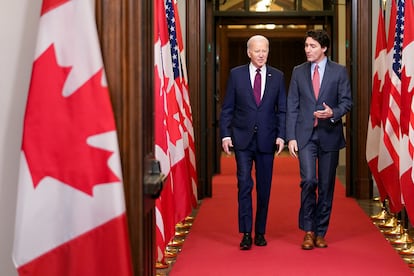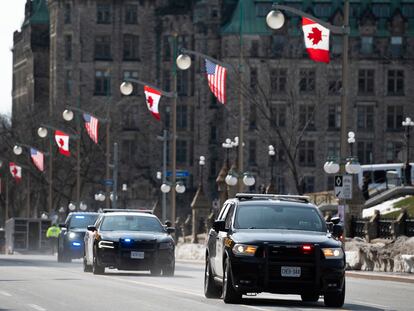United States-Canada migration deal aims to end walk-around crossings
The immigration pact seeks to shut down a process that has enabled tens of thousands of immigrants to move between the countries and pursue asylum cases without going through an official border crossing

The immigration deal announced Friday by U.S. President Joe Biden and Canadian Prime Minister Justin Trudeau aims to shut down a process that has enabled tens of thousands of immigrants from across the world to move between the two countries along a back road between New York state and Quebec.
Since early 2017, so many migrants entered Canada via Roxham Road outside Champlain, New York that the Royal Canadian Mounted Police staffed a reception center to process them, less than five miles (8 kilometers) from the official border crossing where they’d be returned to the United States. Mounties warned they’d be arrested, but once on Canadian soil, they were allowed to stay and pursue asylum cases that can take years to resolve.
The new policy says that any asylum seekers who lack U.S. or Canadian citizenship and are caught within 14 days of crossing will be sent back across the border. It was set to take effect a minute after midnight Saturday, a quick implementation aimed at avoiding a surge of refugee claimants trying to cross, according to Canadian officials who spoke on condition of anonymity to discuss the deal in advance.
“We are expanding the Safe Third Country Agreement to apply not only at designated ports of entry, but across the entire land border, including internal waterways, ensuring fairness and more orderly migration between our two countries,” Canada’s announcement said.
Canada also agreed to allow 15,000 migrants to apply “on a humanitarian basis from the Western Hemisphere over the course of the year, with a path to economic opportunities to address forced displacement, as an alternative to irregular migration.”
Some of the last migrants to make it through were about eight people in two families — one from Haiti, the other from Afghanistan — who arrived at the U.S. end of Roxham Road just after dawn on Friday. Both said they took circuitous routes to get there.
Gerson Solay, 28, carried his daughter Bianca up to the border. He said he didn’t have the proper documents to remain in the United States.
“That is why Canada is my last destination,” he said before he was taken into custody for processing.
The deal comes as the U.S. Border Patrol also responds to a steep increase in illegal southbound crossings along the wide-open Canadian border. Nearly all happen in northern New York and Vermont along the stretch of border nearest Canada’s two largest cities, Toronto and Montreal.
It’s unclear how Roxham Road became a favorite route, but it’s just a taxi ride from where Interstate 87 approaches the Canadian border, and for southbound migrants, it’s a relatively short distance to New York City.
While the numbers are still tiny compared to the U.S.-Mexico border, it’s happening so frequently now that the Border Patrol increased its staffing in the region and has begun releasing some migrants into Vermont with a future date to appear before immigration authorities.
Canadian officials have struggled to cope with this since early 2017. Many northbound migrants said they were fleeing because they feared President Donald Trump’s immigration policies were hostile to their presence in the United States. The process continued since the Biden administration took office.
These migrants have taken advantage of a quirk in a 2002 agreement between the U.S. and Canada that says asylum seekers must apply in the first country they arrive in. Migrants who go to an official Canadian crossing are returned to the U.S. and told to apply there. But those who reach Canadian soil somewhere other than a port of entry are allowed to stay and request protection.
Meanwhile, southbound migrants are straining U.S. border officials.
U.S. Border Patrol agents stopped migrants entering illegally from Canada 628 times in February, more than five times the same period a year earlier. Those numbers pale compared to migrants entering from Mexico – where they were stopped more than 220,000 times in December alone — but it is still a massive change in percentage terms.
In the Border Patrol’s Swanton Sector, which stretches across New Hampshire, Vermont and a portion of upstate New York, agents stopped migrants 418 times in February, up more than 10 times from a year earlier. About half entering from Canada have been Mexicans, who can fly visa-free to Canada from Mexico.
About an hour south of the border, the police chief in St. Johnsbury, Vermont, population 6,000, alerted state officials that the Border Patrol had dropped off a vanload of immigrants with just a few minutes notice at the community’s welcome center. The same thing happened several times before within the last few weeks.
In a statement, U.S. Customs and Border Protection said the migrants dropped off in St. Johnsbury had been apprehended along the border after entering the U.S. without authorization, and were given a notice to appear for later immigration proceedings.
They were dropped off in St. Johnsbury because it has a station where migrants can take a bus to a larger city.
“In such circumstances, USBP works in tandem with local communities to ensure the safety of all parties—both community members and migrants—and to ensure stability in the community’s resources,” the statement said.
But local officials said they weren’t given time to prepare. State officials are now working to set up a system to provide migrants services they might require.
On Thursday, a Haitian couple and their children, boys aged 17 and 9 and a 15-year-old girl, were dropped off at the welcome center. The family, who did not want to give their names, wanted to take a bus to Miami.
They said they’d been in Canada for two months, but wouldn’t talk about what prompted them to keep moving.
They missed the Thursday bus that would allow them to connect to a bus to Boston, where they could catch another bus to Miami. A team of local volunteers spent the day getting them something to eat, finding them a place to stay the night and arranging for them to take the bus on Friday.
Police chief Tim Page said St. Johnsbury wants to help these migrants, but not on the fly.
“We need to get something down so we know what we are going to do when these families arrive,” he said. “We don’t have a system set yet, so when we do I am sure this will all go a little smoother.”
Sign up for our weekly newsletter to get more English-language news coverage from EL PAÍS USA Edition
Tu suscripción se está usando en otro dispositivo
¿Quieres añadir otro usuario a tu suscripción?
Si continúas leyendo en este dispositivo, no se podrá leer en el otro.
FlechaTu suscripción se está usando en otro dispositivo y solo puedes acceder a EL PAÍS desde un dispositivo a la vez.
Si quieres compartir tu cuenta, cambia tu suscripción a la modalidad Premium, así podrás añadir otro usuario. Cada uno accederá con su propia cuenta de email, lo que os permitirá personalizar vuestra experiencia en EL PAÍS.
¿Tienes una suscripción de empresa? Accede aquí para contratar más cuentas.
En el caso de no saber quién está usando tu cuenta, te recomendamos cambiar tu contraseña aquí.
Si decides continuar compartiendo tu cuenta, este mensaje se mostrará en tu dispositivo y en el de la otra persona que está usando tu cuenta de forma indefinida, afectando a tu experiencia de lectura. Puedes consultar aquí los términos y condiciones de la suscripción digital.
More information
Archived In
Últimas noticias
Cubans look to Venezuela fearfully after Trump’s incursion: ‘We could be next’
The operation in Venezuela to capture Maduro threatens to widen the cracks in the MAGA movement
Trump clarifies who is ultimately in charge in Venezuela: ‘Me’
Maduro pleads not guilty before the federal court in New York: ‘I am still the president of Venezuela’
Most viewed
- Alain Aspect, Nobel laureate in physics: ‘Einstein was so smart that he would have had to recognize quantum entanglement’
- Gilles Lipovetsky: ‘If you want to live better and fall in love, take Prozac, don’t look to philosophy’
- Alvin Hellerstein, a 92-year-old judge appointed by Bill Clinton, to preside over Maduro’s trial in New York
- Cuba confirms death of 32 of its citizens in the US attack against Venezuela
- Why oil has been at the center of Venezuela-US conflicts for decades










































